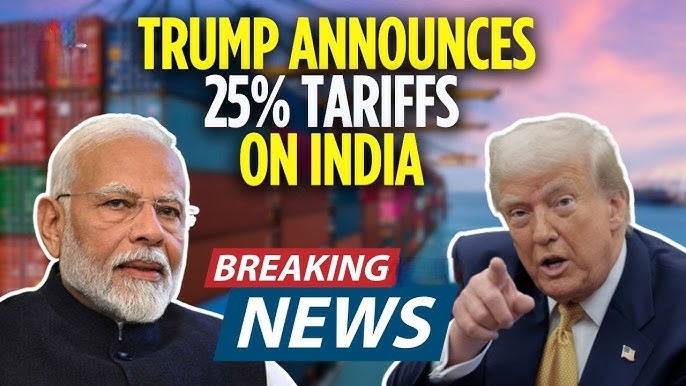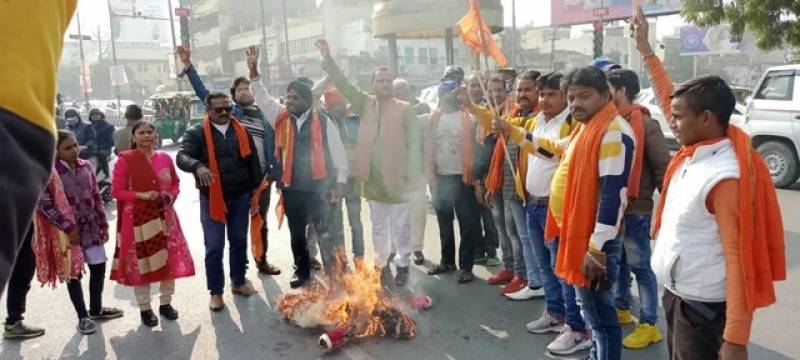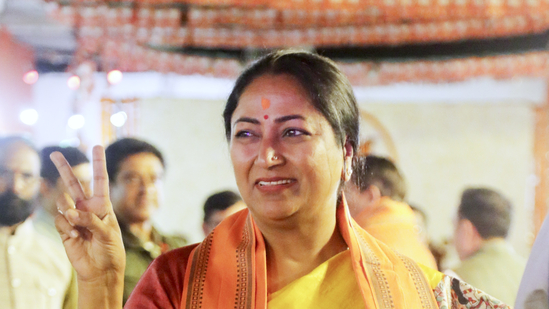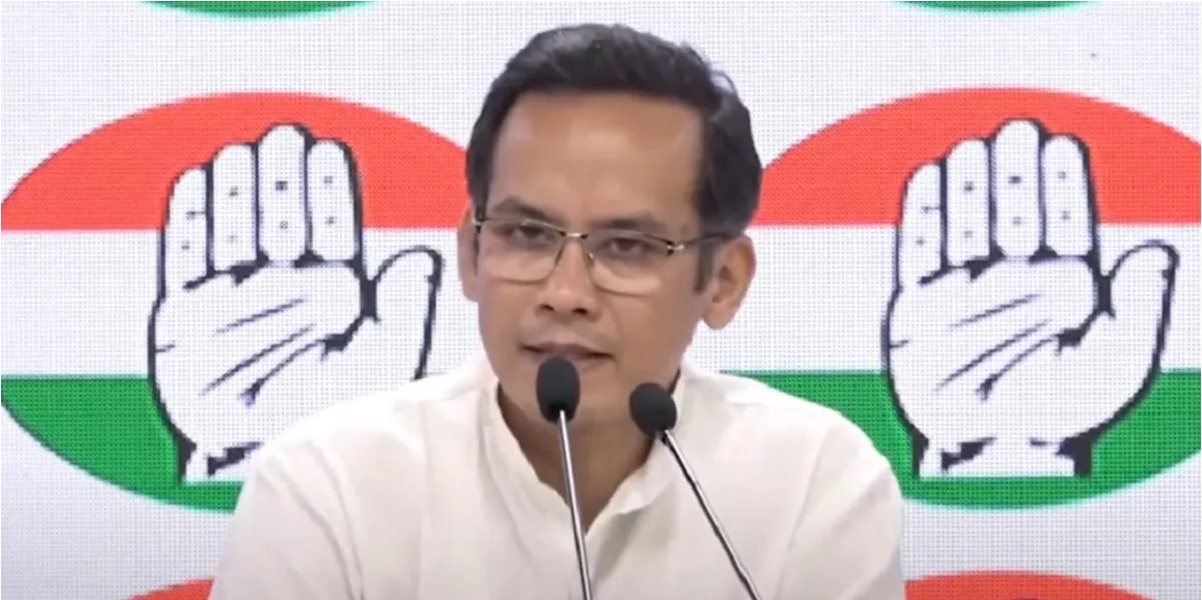Trump Slaps 25% Tariff on Indian Imports | India-Russia Ties, Trade Deficit & Global Fallout Explained
By: Javid Amin | 30 July 2025
A Trade Bombshell That Shook Two Democracies
On July 29, 2025, Donald Trump, the once-and-again President of the United States, announced a sweeping 25% tariff on all Indian imports, effective August 1, 2025. In the same breath, he signaled “punitive economic measures” targeting India’s energy and defense purchases from Russia. The world watched in disbelief as the United States appeared to launch a full-scale trade offensive against the world’s largest democracy—its long-time strategic ally in the Indo-Pacific.
The move, unprecedented in its scope and timing, has shattered the optimism surrounding the near-concluded Bilateral Trade Agreement (BTA) and sent alarm bells ringing in New Delhi, Mumbai, and global markets.
But this is more than a story of tariffs. It is a geo-economic earthquake—bringing trade imbalance, diplomatic realignment, military dependencies, and domestic political consequences all into one headline-grabbing saga.
The Announcement: Trump’s Words That Sent Shockwaves
During an unscheduled press briefing at the White House, President Trump stood behind the podium, flanked by senior trade officials and economic advisors, and declared:
“India has been the most strenuous, obnoxious, and unapologetic in its trade barriers. Enough is enough. We are imposing a 25% tariff on all Indian imports starting August 1. We will also evaluate secondary penalties for their continued cooperation with Russia, especially in oil, gas, and arms trade.”
This sharp escalation came despite months of bilateral trade negotiations that had reportedly reached a breakthrough stage. Within hours, the Indian rupee slid against the dollar, stock markets tumbled, and trade-dependent industries went into crisis mode.
What Triggered This Trade Retaliation?
01. The Trade Deficit Narrative
According to U.S. Commerce Department data, the U.S. had a $45.7 billion trade deficit with India in 2024. Trump, known for his “America First” economic nationalism, has long maintained that such deficits are evidence of unfair trade practices.
India has imposed tariffs or non-tariff barriers on:
-
American tech products
-
Agricultural goods (especially genetically modified crops)
-
Pharmaceuticals
-
E-commerce platforms (Amazon, Walmart’s Flipkart)
Trump described these as “destructive to free trade principles” and “hostile to American business.”
02. Russia: The Real Red Line?
Beyond economics, the elephant in the Oval Office is geopolitics. Trump’s team explicitly referenced India’s status as Russia’s largest buyer of oil, coal, and defense equipment in 2025.
India has continued:
-
Buying discounted Russian oil, paying through alternative currencies
-
Finalizing the S-500 missile defense deal
-
Procuring spare parts for Su-30MKI fighters and T-90 tanks
-
Exploring joint submarine development with Russian firms
While India maintains that its strategic autonomy is vital, Washington clearly sees this as undermining global pressure on Moscow over the war in Ukraine.
“You can’t say you stand with freedom and democracy while bankrolling a dictatorship that’s attacking its neighbor,” said Trump’s National Security Advisor in a follow-up interview.
The Economic Impact: Who Gets Hit in India?
The United States is India’s largest export market, accounting for over $97 billion in goods exports in FY 2024–25. The 25% tariff will affect virtually all sectors, including:
1. Automobiles & Auto Parts
Especially two-wheelers, electric vehicles, and aftermarket parts.
2. Electronics & IT Hardware
India’s laptop, smartphone component, and semiconductor exports face price competitiveness issues.
3. Textiles & Apparel
Nearly 18% of Indian garment exports go to the U.S. The new tariffs will destroy small and mid-scale producers.
4. Gems & Jewellery
India exported over $15 billion in polished diamonds and gold jewelry to the U.S. last year. A 25% hike is crippling.
5. Processed Food & Spices
Indian food brands that rely on the diaspora market are set to see volume collapses.
GDP and Rupee Outlook: Storm Clouds Ahead
Economists at Morgan Stanley and Nomura estimate that the tariff shock could shave 0.6%–0.9% off India’s GDP growth in FY26. Meanwhile, the rupee has already slipped past ₹86/USD, and analysts expect continued volatility.
“The timing couldn’t be worse,” said Raghuram Iyer, a trade economist. “India is already battling monsoon disruptions, slowing domestic demand, and now faces an external demand crisis.”
Diplomacy in Disarray: A Bilateral Deal on the Brink
For nearly three years, India and the U.S. had been negotiating a Bilateral Trade Agreement (BTA), aimed at resolving legacy issues on:
-
Data localization
-
Agriculture subsidies
-
Intellectual property protection
-
Market access for dairy and poultry
With Trump’s tariff move, these talks have collapsed.
Indian officials, speaking on condition of anonymity, said:
“It feels like everything we worked on has gone down the drain overnight.”
India’s Response: Strategic Patience or Retaliation?
New Delhi is in a tight spot. With general elections behind it and the Modi government freshly re-elected, there is pressure to act decisively, but also avoid a full-scale trade war.
Possible Indian Responses:
-
Raising tariffs on American whiskey, almonds, and Harley-Davidson bikes
-
Deferring certain U.S. defense procurements
-
Exploring wider market diversification in ASEAN, Africa, and Europe
-
Appealing through the WTO dispute resolution system
FICCI and Industry Bodies Urge Restraint
The Federation of Indian Chambers of Commerce and Industry (FICCI) released a statement:
“We are deeply concerned about the tariff decision. We urge both governments to prioritize diplomacy and swiftly return to the negotiating table.”
Global Reactions: Allies, Markets, and China’s Opportunism
European Union
The EU called for “restraint and multilateral resolution” but privately sees a strategic opening to strengthen India-Europe economic ties.
China
Beijing has not officially commented but experts warn that China could use this rift to lure India away from U.S. strategic alignments in the Indo-Pacific.
Markets
Global equity markets saw an initial dip but stabilized by the next trading day. However, Indian indices remained in the red due to export exposure fears.
Strategic Analysis: Is This More Than a Trade War?
This is not just about trade numbers. This is Trump’s reassertion of his foreign policy vision—transactional, unilateral, and strategically punishing to those who hedge too much.
What Does Trump Want?
-
India to sever or reduce ties with Russia
-
Indian markets to open more to American agribusiness, pharmaceuticals, and tech
-
Leverage to extract future defense and intelligence concessions
What Does India Want?
-
Autonomy in foreign policy
-
Protection for vulnerable export sectors
-
Freedom to buy energy from the cheapest suppliers
The collision of these goals has created the perfect storm.
What Lies Ahead: Five Possible Scenarios
-
Backroom Deal in August
Quiet diplomacy could result in a partial rollback of tariffs, especially if industry lobbying intensifies. -
Escalation into Full Trade War
If India retaliates harshly, a prolonged standoff could damage global supply chains. -
WTO Arbitration
India could drag the U.S. to the World Trade Organization, though results may take years. -
Modi-Biden Mediation
As Trump eyes 2028, Biden or European powers may offer behind-the-scenes mediation. -
Geopolitical Realignment
India may accelerate trade and security diversification, boosting ties with France, Japan, and the UAE.
Political Fallout in India: Modi Under Pressure
While Prime Minister Modi remains India’s most popular leader, this tariff bomb has created political pressure from opposition leaders, farmer lobbies, MSME associations, and tech exporters.
Congress Leader Priyanka Gandhi Vadra said:
“This is what happens when you rely on photo-ops over policy. The government must protect India’s economic sovereignty and people’s livelihoods.”
The Modi government has called for an all-party meeting next week to build consensus on the response—an unusually inclusive move, given India’s typically centralized diplomacy.
Bottom-Line: More Than Tariffs—A Test of India’s Maturity
Trump’s 25% tariff on Indian imports is a wake-up call—not just for Indian exporters or diplomats, but for the nation as a whole. It reveals the fragility of global friendships, the limits of strategic ambiguity, and the unforgiving nature of transactional geopolitics.
This is no longer just about trade—it is about:
-
How India chooses its allies
-
How India defends its economy
-
How India asserts its voice in a multipolar world
Whether this ends in diplomacy or disaster, one thing is certain: India’s choices today will shape its global standing for the next decade.



